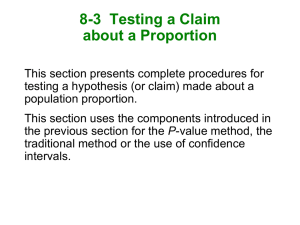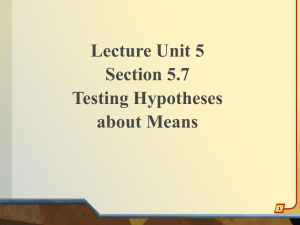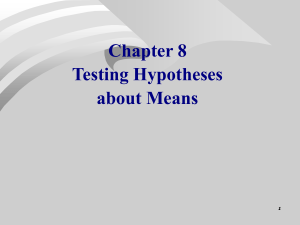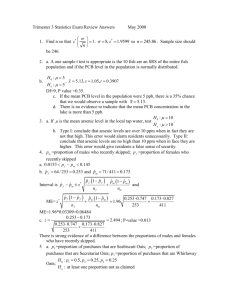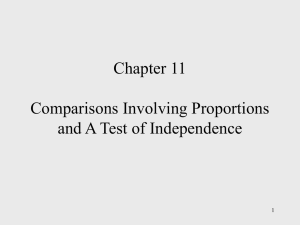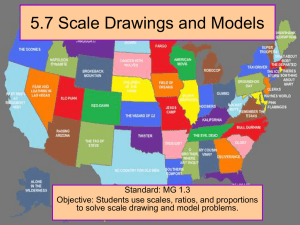Ch8-3
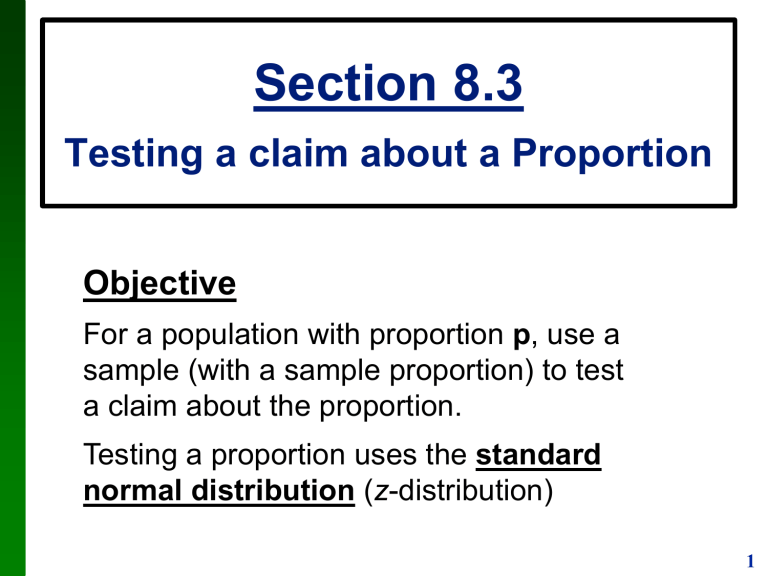
Section 8.3
Testing a claim about a Proportion
Objective
For a population with proportion p , use a sample (with a sample proportion) to test a claim about the proportion.
Testing a proportion uses the standard normal distribution ( z -distribution)
1
Notation
2
Requirements
(1) The sample used is a a simple random sample
(i.e. selected at random, no biases)
(2) Satisfies conditions for a Binomial distribution
(3) np
0
≥ 5 and nq
0
≥ 5
Note : 2 and 3 satisfy conditions for the normal approximation to the binomial distribution
Note: p
0 is the assumed proportion, not the sample proportion
3
Test Statistic
Denoted z (as in z -score) since the test uses the z-distribution .
4
Traditional method:
If the test statistic falls within the critical region, reject H
0
.
If the test statistic does not fall within the critical region, fail to reject H
0
(i.e. accept H
0
).
5
Types of Hypothesis Tests:
Two-tailed, Left-tailed, Right-tailed
The tails in a distribution are the extreme regions where values of the test statistic agree with the alternative hypothesis
6
Lefttailed Test “<”
H
0
: p = 0.5
H
1
: p < 0.5
significance level
Area =
-z
( Negative )
7
Righttailed Test “>”
H
0
: p = 0.5
H
1
: p > 0.5
significance level
Area =
z
( Positive )
8
Twotailed Test “≠”
H
0
: p = 0.5
H
1
: p ≠ 0.5
significance level
Area =
/2
-z
/2
Area =
/2 z
/2
9
Example 1
The XSORT method of gender selection is believed to increases the likelihood of birthing a girl.
14 couples used the XSORT method and resulted in the birth of 13 girls and 1 boy.
Using a 0.05 significance level, test the claim that the
XSORT method increases the birth rate of girls.
(Assume the normal birthrate of girls is 0.5)
What we know: p
0
= 0.5
n = 14 x = 13 p = 0.9286
Claim: p > 0.5 using α = 0.05
n p
0
= 14*0.5 = 7 n q
0
= 14*0.5 = 7
Since n p
0
> 5 and n q
0
> 5, we can perform a hypothesis test.
10
Example 1
What we know: p
0
= 0.5
n = 14 x = 13 p = 0.9286
Claim: p > 0.5 using α = 0.01
H
0
: p = 0.5
H
1
: p > 0.5
Right-tailed
Test statistic: z
α
= 1.645
z = 3.207
Critical value: z in critical region
Initial Conclusion: Since z is in the critical region, reject H
0
Final Conclusion: We Accept the claim that the XSORT method increases the birth rate of girls
11
P-Value
The P-value is the probability of getting a value of the test statistic that is at least as extreme as the one representing the sample data, assuming that the null hypothesis is true.
Example z Test statistic z
α
Critical value
P -value = P (Z > z ) p-value
(area) z z
α
12
P-Value
Critical region in the right tail:
P-value = area to the right of the test statistic
Critical region in the left tail:
P-value = area to the left of the test statistic
Critical region in two tails:
P-value = twice the area in the tail beyond the test statistic
13
P-Value method:
If P-value
, reject H
0
.
If P-value >
, fail to reject H
0
.
If the P is low, the null must go.
If the P is high, the null will fly.
14
Caution
Don ’t confuse a P-value with a proportion p .
Know this distinction:
P-value = probability of getting a test statistic at least as extreme as the one representing sample data p = population proportion
15
Calculating P-value for a Proportion
Stat → Proportions → One sample → with summary
16
Calculating P-value for a Proportion
Enter the number of successes ( x ) and the number of observations ( n )
17
Calculating P-value for a Proportion
Enter the Null proportion ( p
0
) and select the alternative hypothesis ( ≠ , < , or > )
Then hit Calculate
18
Calculating P-value for a Proportion
The resulting table shows both the test statistic ( z ) and the P-value
Test statistic
P-value = 0.0007
P-value
19
Example 1 Using P-value
What we know: p
0
= 0.5
n = 14 x = 13 p = 0.9286
Claim: p > 0.5 using α = 0.01
H
0
: p = 0.5
H
1
: p > 0.5
Stat → Proportions→ One sample → With summary
Number of successes: 13
● Hypothesis Test
Null : proportion=
Number of observations:
14
Alternative
0.5
>
P-value = 0.0007
Initial Conclusion: Since p-value < α ( α = 0.05), reject H
0
Final Conclusion: We Accept the claim that the XSORT method increases the birth rate of girls
20
Do we prove a claim?
A statistical test cannot definitely prove a hypothesis or a claim.
Our conclusion can be only stated like this:
The available evidence is not strong enough to warrant rejection of a hypothesis or a claim
We can say we are 95% confident it holds.
“The only definite is that there are no definites” -Unknown
21
Example 2
Mendel’s Genetics Experiments
Problem 32, pg 424
When Gregor Mendel conducted his famous hybridization experiments with peas, one such experiment resulted in 580 offspring peas, with 26.2% of them having yellow pods. According to Mendel’s theory, ¼ of the offspring peas should have yellow pods. Use a 0.05 significance level to test the claim that the proportion of peas with yellow pods is equal to ¼.
What we know: p
0
= 0.25
n = 580 p = 0.262
Claim: p = 0.25 using α = 0.05
n p
0
= 580*0.25 = 145 n q
0
= 580*0.75 = 435
Since n p
0
> 5 and n q
0
> 5, we can perform a hypothesis test.
22
Example 2
What we know: p
0
= 0.25
n = 580 p = 0.262
Claim: p = 0.25 using α = 0.05
H
0
: p = 0.25
H
1
: p ≠ 0.25
Two-tailed
Test statistic: z
α
= -1.960
z = 0.667
Critical value: z
α
= 1.960
z not in critical region
Initial Conclusion: Since z is not in the critical region, accept H
0
Final Conclusion: We Accept the claim that the proportion of peas with yellow pods is equal to ¼
23
Example 2 Using P-value
What we know: p
0
= 0.25
n = 580 p = 0.262
Claim: p = 0.25 using α = 0.05
H
0
: p = 0.25
H
1
: p ≠ 0.25
Stat → Proportions→ One sample → With summary
Number of successes: 152
● Hypothesis Test
Null : proportion=
Number of observations:
580
Alternative
0.25
≠
x = np = 580*0.262 ≈ 152
P-value = 0.5021
Initial Conclusion: Since P-value > α , accept H
0
Final Conclusion: We Accept the claim that the proportion of peas with yellow pods is equal to ¼
24


